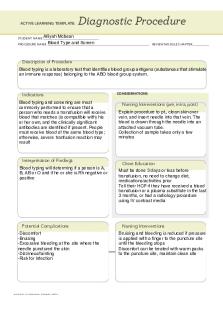Lab #1 and #2 Notes - Goniometry and Lower Quarter Screen PDF

| Title | Lab #1 and #2 Notes - Goniometry and Lower Quarter Screen |
|---|---|
| Course | Lower Extremity Assessment |
| Institution | University of Hawaii at Manoa |
| Pages | 3 |
| File Size | 54.1 KB |
| File Type | |
| Total Downloads | 57 |
| Total Views | 152 |
Summary
Goniometry and Lower Quarter Screen...
Description
Lab #1 and #2 – Goniometry and Lower Quarter Screen: Goniometry – the measurement of angles created at human joints by the bones of the body may be used to determine both a particular joint position and the total amount of joint motion available post-operative ROM assessment o total knee arthroplasty (TKA) vs. ACL reconstruction immobilization tight musculature Anatomy of the Goniometer – 1. moving arm 2. stationary arm 3. fulcrum Range of Motion – arc of motion that occurs at a joint or series of joints the starting position is usually in the anatomical position the anatomical position is usually termed as 0 degrees o if 0 degrees cannot be reached, note the new starting point and reasoning Positioning – start with anatomical position when necessary use the same starting position every time you test that joint or person the test must be done bilaterally and in both AROM and PROM Alignment – use body anatomical landmarks to align the arms of the goniometer both proximal and distal the landmarks are universal and should be used whenever possible use textbook for landmarks (green boxes) stationary arm = proximal joint segment moving arm = distal joint segment fulcrum = axis of motion Documentation – patient’s name date and time positioning ROM including beginning and end degrees normal ROM comparison active or passive special notes (differences, noises, end feels, etc.)
Common Mistakes – fulcrum moves during ROM inconsistent alignment reading goniometer incorrectly sloppy measurements not documenting your results Lower Quarter Screening – familiarize yourself with page 26 will practice dermatomes, myotomes, and reflexes in lab Dermatomes from Lumbar and Sacral Plexus – signs and symptoms: o paresthesia = altered sensation numbness tingling shooting pain burning L1-L5 S1 and S2 Two Point Discrimination – normal is 4-5mm also assess dull, sharp, and other sensations o pressure o temperature o pain Myotomes Neuro – table 1.1 - motor: o innervation of all muscles tends to overlap o weakness in motor test screen that is innervated by a specific nerve root, identify another muscle that shares that innervation and perform a manual muscle test o if only one muscle is weak, pathology to the muscle or the peripheral nerve supplying it (if different from the second muscle) should be suspected o if both muscles are weak, then the nerve root or peripheral nerve supplying the muscles is implicated Deep Tendon Reflex (DTR) – SAD MEV = sensory, afferent, dorsal horn, and motor, efferent, ventral 0 = no response 1 = hyporeflexia
2 = normal 3 = hyperreflexia 4 = hyperactive clonus L4-L5 S1 and S2
Jendrassik Maneuver – attempts to relax patient for DTR...
Similar Free PDFs

Ankle and Lower Leg Notes Lower
- 11 Pages

Marketing- Quarter 1 HW and Notes
- 10 Pages

BC 3rd Quarter Module 1 and Module 2
- 131 Pages

Hip Muscles and lower body
- 2 Pages

Spinal Cord and Lower Brain
- 5 Pages

JFE Screen Copy - Apuntes 1-2
- 6 Pages

Lab 8 - Green Screen Effect
- 5 Pages
Popular Institutions
- Tinajero National High School - Annex
- Politeknik Caltex Riau
- Yokohama City University
- SGT University
- University of Al-Qadisiyah
- Divine Word College of Vigan
- Techniek College Rotterdam
- Universidade de Santiago
- Universiti Teknologi MARA Cawangan Johor Kampus Pasir Gudang
- Poltekkes Kemenkes Yogyakarta
- Baguio City National High School
- Colegio san marcos
- preparatoria uno
- Centro de Bachillerato Tecnológico Industrial y de Servicios No. 107
- Dalian Maritime University
- Quang Trung Secondary School
- Colegio Tecnológico en Informática
- Corporación Regional de Educación Superior
- Grupo CEDVA
- Dar Al Uloom University
- Centro de Estudios Preuniversitarios de la Universidad Nacional de Ingeniería
- 上智大学
- Aakash International School, Nuna Majara
- San Felipe Neri Catholic School
- Kang Chiao International School - New Taipei City
- Misamis Occidental National High School
- Institución Educativa Escuela Normal Juan Ladrilleros
- Kolehiyo ng Pantukan
- Batanes State College
- Instituto Continental
- Sekolah Menengah Kejuruan Kesehatan Kaltara (Tarakan)
- Colegio de La Inmaculada Concepcion - Cebu








